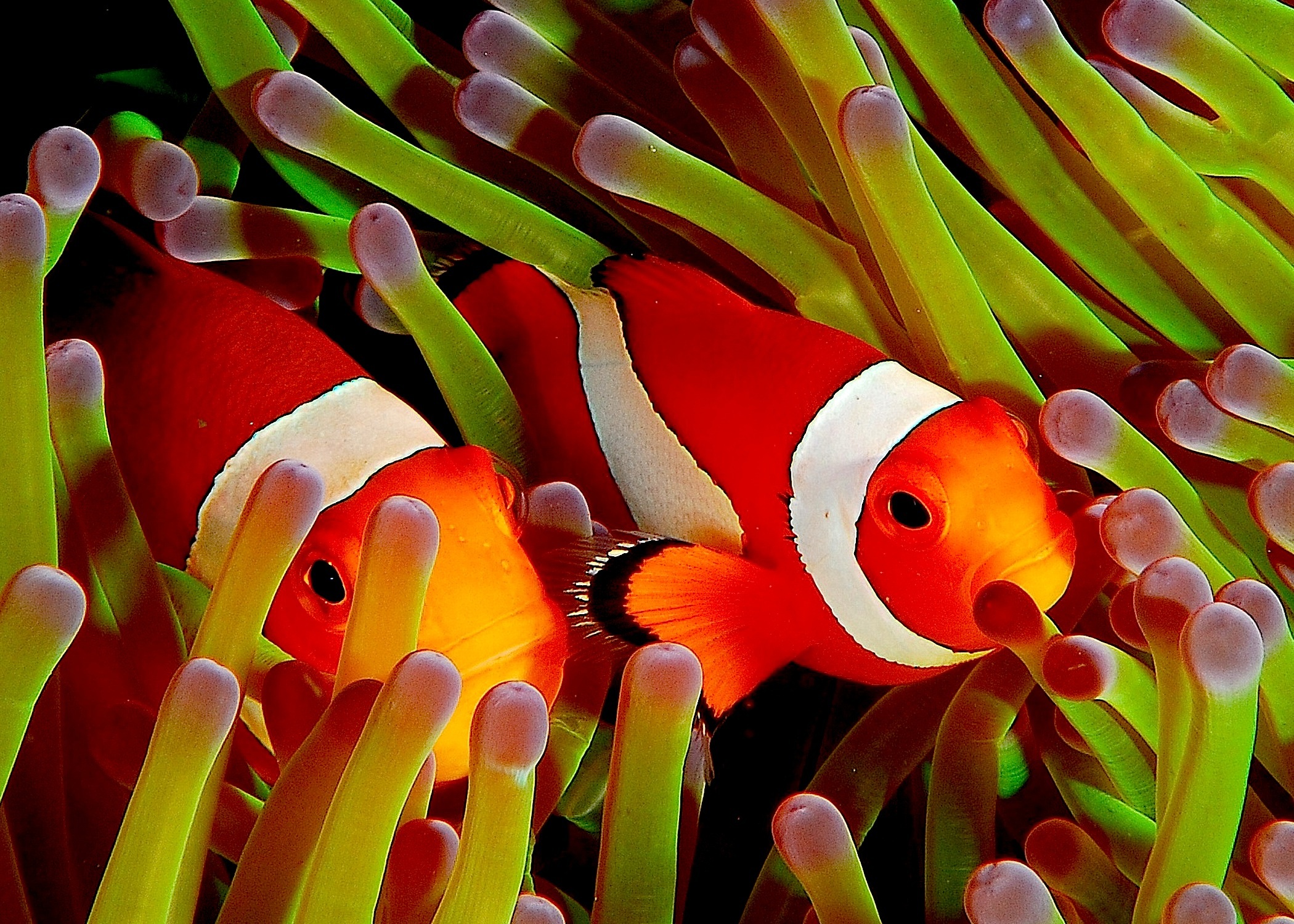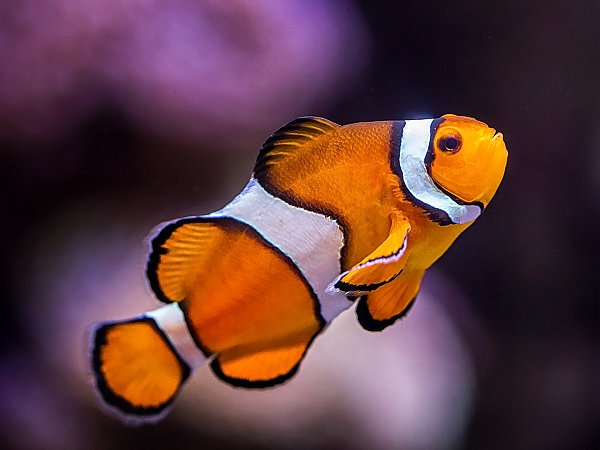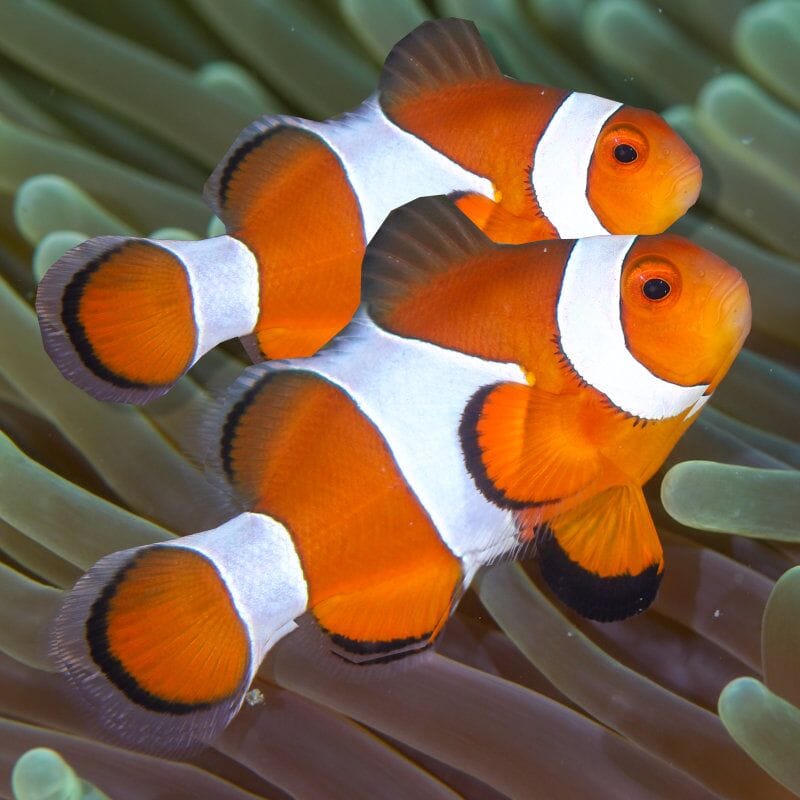The ocellaris clownfish has been captive-bred and now is available in a wide variety of colors and clownfish color patterns. Some of the most popular clownfish on sale are captive bred. Captive bred marine fish for sale are now available across many families of species. The most popular clownfish, and one of the most commonly kept saltwater aquarium fish, is the Percula Clownfish. This fish has a rival that looks almost the same, the False Percula Clownfish! Some saltwater aquarists say the difference between the True and False Percula Clownfish is simply that the false species is tank-raised in captivity. The clownfish can also defend the anemone against some reef fishes which could eat the tentacles such as butterflyfishes. Clownfish Appearance. Clownfish are highly distinctive in coloring, with their orange scales and white and black stripes. Many clownfish will darken as they get older, and breeders will selectively mate pairs that produce different color patterns and hues – creating designer clownfish. Clownfish are part of the species of anemonefish, named for the sea anemones in which they make their homes, confirms Lewbart. There are 28 species of these fish, however clownfish are the most commonly kept species, he said. Fact #2: They’re More Colorful Than You Think.
Since Disney’s release of Finding Nemo and Finding Dory, the clownfish species’ popularity has skyrocketed. But did you know they are actually a fun and easy fish to care for?
Amphiprion ocellaris is their scientific name, but they go by a variety of names – mostly known as the Common Clownfish or the False Percula Clownfish.
They’re also called Western Clownfish, Anemone Demoiselle, False Clownfish, False Clown Anemonefish, Western Clown Anemonefish, Anemone Fish, Clown Anemonefish, Damselfish, and more recently, the Nemofish. Whew!
Clownfish are great saltwater species to have if you’re concerned with sustainability, as they are easy to breed in captivity. Most of the fish you’ll find are captive-bred, which also makes them less expensive than other saltwater fish.
If you’re considering one for you tank, however, it’s important to understand that their care isn’t as simple as garden-hose water and some fish flakes.
Here we break down all the complicated – and easy – information you need to add a Clownfish to your aquarium.
Contents
- 3 Clownfish Care
- 4 Clownfish Tank Mates
Clownfish Appearance
Clownfish are highly distinctive in coloring, with their orange scales and white and black stripes. Many clownfish will darken as they get older, and breeders will selectively mate pairs that produce different color patterns and hues – creating designer clownfish.

While these fancier fish can be very expensive, your basic orange buddy should be readily available at larger pet stores or fish shops. Each clownfish has a slightly different pattern, making them all as unique as their friendly personalities.
Clownfish usually grow between 3-4 inches in length, and in a tank, can live over ten years. There have been some cases where a particularly cared-for clown lives over twenty years!
Clownfish Personality
They are peaceful fish with a big personality. They do not need a lot of room, because unlike many other fish, they swim in short bursts of up and down motion, coming in and out of anemones or rocks that serve as their home.
They are omnivores, and can live alone or in small groups.
All clownfish juveniles are sexually ambiguous, meaning they show neither male nor female traits. As they get older, they will change into either males, which are smaller, or females, which are larger and more aggressive.
From there, they form mated pairs. If you put two females together, eventually the smaller or less dominant one will become a male, and they will pair up.
In the wild, clownfish form symbiotic relationships with anemones. They are immune to the sting of certain species of anemones, and so use it as shelter.
They chase away other fish that might eat the anemone, and in return the anemone protects it from larger fish that might try to eat the clownfish.
Download sketchup 2017 full crack 32bit. There are certain anemones you can buy to put in your home tank, and your clownfish may make it its new home!
Clownfish Care
Tank Requirements
Because of how they swim, clownfish can thrive in smaller or larger tanks.
A single or a pair of clownfish can be quite happy in a 10 gallon tank, but they are also able to live in a larger tank, or a reef-styled tank with a lot of other fish.
As long as the clownfish have a host anemone, coral, or rock to stay in, they will be happy.
Water Quality
As with all fish tanks, the water, substrate, and decorations should be cycled in the tank before fish are introduced.
Many pet stores offer salt water ready to go, but you can also mix your own salt water, which requires more work and precision.
The water in the tank should be kept at a temperature between 73 and 80 degrees Fahrenheit, with a ph between 8.0 and 8.4.
Specific gravity should be between 1.021 and 1.026 with a ppt 29 to 35.
The rest of the water requirements should be about the same as any other salt water tank—low ammonia and nitrates, and nitrites less than .2 ppm.
If your tank has only fish, strong lighting is not necessary, but if you’re keeping anemones with your clownfish, you should have very strong lighting to keep them healthy.
Tank Set-up
If you already have fish in your tank and want to add a clownfish, the best way to do so is in a quarantine tank first.
This not only keeps a potentially sick fish away from the others, but it allows the new fish to get used to the water and food you are providing, reducing stress.
Before you remove your clownfish from quarantine, make sure that the tank has several places for the clownfish to hide.

Rearrange the current layout of your tank to distract the existing fish and remove any established territories. Feed your current fish right before introducing the new one, as this will make them less aggressive.
It is also better to introduce more than one new fish at a time, as it reduces the chances of one fish being singled out and aggravated.
And, as always, make sure you water is clean and appropriately balanced to reduce stress in all of the occupants. Initial d arcade stage 8 aax pc download.
Tank Maintenance
Once a tank is set up and the fish are happy, water changes are the best way to maintain a healthy environment. Smaller tanks require more frequent water changes, since toxins such as ammonia and nitrates build up more quickly compared to larger tanks.
For tanks with only fish, and no live rock or anemones, water changes should be as follows:
- Tanks up to 40 gallons: 15% water changes bi-weekly
- Tanks 40-90 gallons: 20-30% water changes monthly
- Tanks 100+ gallons: Once the water is aged and stable, 20-30% water change every six weeks
Clownfish Predators
For reef tanks, water changes should be:
- Tanks up to 40 gallons: 5% water changes weekly
- Tanks 40-90 gallons: 15% water changes bi-weekly
- Tanks 100+ gallons: Once the water is aged and stable, 10% bi-weekly to 20% monthly
Clownfish Food
Clownfish are pretty aggressive eaters, and will eat either meaty foods or plant-based foods. Generally, any flake or pellet made for carnivores or omnivores will suffice.
A varied diet will keep a healthier fish, and many prefer live or frozen foods to spice up the diet.
They should be fed at least once a day, but many do better with twice-daily feedings. Feed them as much as they can eat in two or three minutes.
Overfeeding can lead to a lot of debris in the tank, which can lead to algae or other problems. Some of this can be negated by cleaning creatures, such as snails, crabs, or starfish.
Because clownfish are laid-back and friendly, you may be able to feed them by hand once they’ve acclimated to the tank.
Clownfish Tank Mates
Since clownfish are small and slow-moving, it’s important that they are not placed with larger carnivores like Lionfish, Snappers, Triggers, Eels, and Groupers.

Undefined reference to ceil. Aside from predatory fish, clownfish are very good with a variety of other fish. They do just as well with fish-only tanks, tanks with coral, community tanks, and reef tanks.
They do not need an anemone to stay alive or healthy, but many people like to pair them with one – because, let’s face facts, it’s cute!
Fish that make good tank-mates with clownfish include: Damselfish, Tangs, Wrasses, Blennies, Angelfish, Dartfish, Puffers, Gobies, Pseudochromis, and Marine Invertebrates.
However, clownfish often will not get along with other species of clownfish, unless they’re a mate.
Clownfish and Anemones
Although wild clownfish always live with anemones, they do not need one in captivity. However, if you would like to keep one in your tank, anemones need some special care.
There is no way to make your clownfish host the anemone, but there are certain breeds of anemone which clownfish prefer over others.
They include the Bubble Tip Anemone (also called the Rose Bubble Tip or Bulb Tentacle), Magnificent Anemone (Ritteri Sea Anemone), Giant Carpet Anemone, and the Saddle Carpet Anemone (Haddon’s Sea Anemone.)
Clownfish Voice Changer Not Working
To successfully keep these anemones alive, your tank should be stable with strong filtration and solid water movement.
Large fluctuations in PH or salinity are very damaging, and they also need strong lighting.
To keep your anemone alive, you shouldn’t need to feed it so long as the clownfish is hosting it, but if it’s living solo, be sure to drop meaty foods such as shrimp into its tentacles.
Eventually your clownfish should gravitate towards it, but sometimes they never host an anemone, so be prepared to include rock or coral in your aquarium so the clownfish still can find a home.
Here’s a video showing a clownfish and anemone pairing.
Clownfish Habitat
Health Concerns
Being captive-bred, clownfish are usually very hardy and resistant to disease as long as your tank is well-maintained.
Clownfish are susceptible to the same diseases as other marine fish, such as bacterial, fungal, parasitic, or other diseases and injuries.
Any saltwater fish will get sick if a tank is not properly maintained with good water quality and stable temperatures. Fish may get stressed with an unclean tank, or with inappropriate tank mates.
Stressed fish, like stressed humans, are more likely to get sick.
Clownfish are particularly prone to parasites such as Ich. Luckily, all parasites are treatable if caught quickly.
There are many medications available at pet stores to treat these parasites, such as Quick Cure. Talk to your local fish specialist for suggestions if you notice your clownfish has signs of disease.
Disease can be introduced to the tank when you add anything that has not been properly cleaned or quarantined, including live rock, corals, and fish.
Clownfish
The best prevention is proper care and cleaning of anything new going into the tank, as well as making sure that you provide quality food, clean good water, and proper tank mates.

With these simple steps, you can enjoy the companionship of your clownfish and its buddies for years to come.
Clownfish For Discord
Are you the owner of any Clown fish?